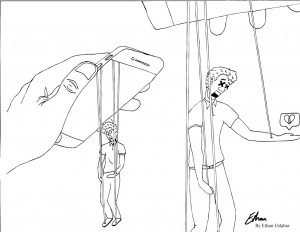Jaywalking into fines: When did crossing the street get so complicated?
“Make sure to look both ways before crossing the street!”
Nearly all of us heard this from our parents as kids. The University Police at UW Oshkosh have been taking this idea one step further by cracking down on pedestrian violations at the crosswalks in front of Dempsey and Sage Hall (Algoma Boulevard and High Avenue, respectively) with a “crosswalk safety initiative.”
According to the UP’s interpretation of Wisconsin state statute 346.38 (2), “No pedestrian, bicyclist or person on any device can cross if there is a ‘Don’t Walk’ sign or signal.” The fine for violating this law is $150.10 for the first offense and $175.30 for a second offense within a year.
“This initiative was completely focused around the safety of our students and staff that cross within our campus, so it’s all about the safety of our campus community,” UP Lt. Trent Martin said.
Although I appreciate UP looking out for the safety of students and drivers, this effort to focus on this virtually unenforceable law is ultimately futile.
I, Leo Costello, tried abiding by the pedestrian laws. It hurts.
On one occasion, a driver waved for me to cross, but instead I pressed the button, waited forever for the walk sign to go on, then crossed the street as the driver beeped at me. They had to wait another minute or so to move forward.
I spent half an hour at both the High Avenue and Algoma Boulevard crosswalks during the afternoon to tally how many people crossed the street legally or illegally as well as how many times the crosswalk button was pushed.
At Algoma Boulevard, roughly 267 people crossed legally, 539 crossed illegally and 11 pressed the button. At High Avenue, roughly 39 people crossed legally, 152 crossed illegally and 15 pressed the button.
This means that with a total of about 1,000 people, only 26 pressed the button. Only 31% of pedestrians crossed the street legally.
If every student who crossed illegally were fined for a first-time offense, that would be a total of $103,719.10 in just one hour. The university could build a couple bridges with that money.
But here’s the thing — I never once saw a single situation that even came close to an accident. In fact, Martin said he couldn’t recall the last time there was an accident at these crosswalks.
I did, however, see some interesting common occurrences at the crosswalks:
• Drivers often wait for students to cross when the “Don’t Walk” sign is on and visibly get irritated when they wait for the crossing light to come on.
• Pedestrians often press the button and immediately cross the street illegally without waiting for the crossing sign to come on. This leaves drivers stranded with no pedestrians in sight.
• The time it takes for the crossing light to turn on varies drastically. Sometimes it’s immediate, other times it takes about 30 seconds or maybe even longer.
• The crossing sign sometimes goes on for no apparent reason. These crosswalks do not have motion sensors.
• Many of the pedestrians who cross legally probably do so by accident. They’re not the ones pressing the button.
• Most of the button pressers seem like they’re not in a hurry.
As it stands right now, the status quo of pedestrians and drivers at these crosswalks seems to be established. Pedestrians often let drivers go by and drivers often stop unprompted for students to pass. There’s a bit of a beautiful hive mind thing going on that seems to be working even though most pedestrians are technically crossing illegally.
Martin seems to be aware there is a problem with the current setup at these crosswalks.
“We notice that a lot of times people don’t want to push the button because they don’t want to affect traffic and get traffic to stop for them, but that’s really what’s expected and required in order for them to cross,” he said.
Let’s suppose everyone abode by the pedestrian laws on campus. If every single student crossing Algoma Boulevard or High Avenue at the crosswalks pressed the button and waited until the crossing signal, the sidewalks and roads would get really blocked up.
Large groups of students would have to wait patiently until they could cross, then once the “Don’t Walk” sign came on, another large group of students would have to wait for who knows how long to cross. Many students would end up tardy to their classes, especially since a lot of those students have to cross both streets.
From the driver’s perspective, abiding by the laws all of the time would also cause problems. Drivers would, on average, have to wait more. In the case of a single or a few pedestrians (something that happens a lot throughout the day), drivers would have to wait for them to press the button, wait for the crossing signal to turn on, wait for them to cross and then wait for the green light. What a waste of time.
Pedestrians don’t abide by the crosswalk laws at Algoma Boulevard and High Avenue because the system is broken for these areas. Why would you press the button if there aren’t any cars? Why wouldn’t you cross if the vehicles are clearly giving you the right of way? How can you resist going with the crowd when they all cross at once?
“When a pedestrian is crossing outside of these crosswalk zones or is crossing when they’re not supposed to, it creates confusion for the drivers and then that safety concern is what we don’t want,” Martin said.
So what should happen to fix this problem? Clearly crossing lights are not working. Perhaps the lights should be removed. Perhaps speed bumps should be installed. Perhaps we should have crossing guards at these crosswalks. Why does something as simple as crossing the street have to be so complicated?
Based on what I’ve seen, I think the most effective solution would be to replace the crossing lights on Algoma Boulevard and High Avenue with the same kind of crosswalk in front of Reeve Memorial Union with the flashing yellow lights. Pressing the button at that crosswalk immediately makes the warning lights flash, giving pedestrians the right of way, but vehicles can still drive through if there are no students present.
Having this consistency with crosswalks on campus would not only organize the chaos between pedestrians and drivers, but it would reduce confusion and waiting time, as well as help ensure the safety of everyone on the road.










